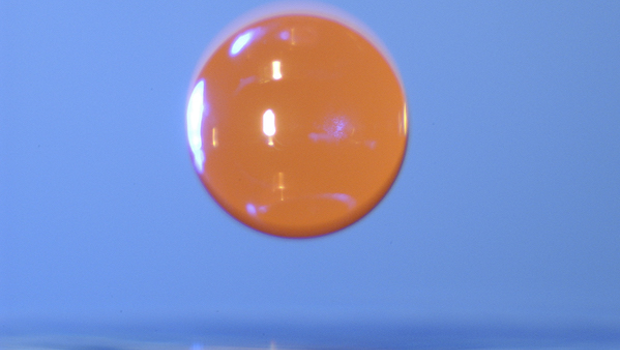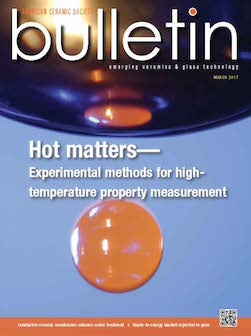
[Image above] A molten sample of titanium-zirconium-nickel alloy floats inside an electrostatic levitator at NASA’s Marshall Space Flight Center (Huntsville, Ala.). Measuring material properties during suspension prevents contamination from containers and is a technique used to make measurements of ceramic materials, too. Credit: NASA/MSFC/Emmett Given
The March 2017 issue of the ACerS Bulletin is now available online.
In March’s cover story, authors Alexandra Navrotsky and Sergey V. Ushakov explore how hot matter matters with their review of experimental methods for measuring high-temperature properties of refractory ceramics. These experiments provide the data necessary to engineer new materials—which are precisely what’s needed, because existing superalloy materials are reaching their high-temperature limits. Recent advances are opening up potential avenues for computational design to develop new ceramic materials, widening their extreme service applications. As Navrotsky and Ushakov say, “Think big, bold, and hot!”
The new issue also includes a feature story detailing conductive ceramic membranes that can increase the efficiency and reduce operating expenses of water-treatment plants. Authors Robert Sterner and Jay Huang, from Magneli Materials LLC, detail the company’s novel manufacturing process to produce industrial quantities of Magneli-phase titanium dioxide, an electrically conductive ceramic with industrial processing applications. In addition to developing Magneli-phase titanium oxide-coated anodes for industrial water treatment, Magneli Materials recently fabricated a ceramic reactive membrane that can decrease operating expenses and decrease processing times by 50% in water-treatment plants.
And in the Bulletin’s new business and market view column, BCC Research analyst Maya Agnani highlights the upcoming forecast for thermal and biological waste-to-energy markets. Waste-to-energy is precisely what it sounds like—using waste to generate electricity or heat. This market is rising in popularity due to its ability to eliminate waste and is predicted to grow at a compound annual growth rate of 5.7% over the next few years. Flip open to the column to glimpse some of the leading companies and key drivers for this growing market.
And don’t miss the recaps from January’s ICACC’17 and EMA 2017 meetings. In addition to details and images from this year’s meetings, be sure to catch the brief history of ICACC’s move to Daytona Beach (from the meeting’s prior location in Cocoa Beach), which celebrated its 10th anniversary of the move this year.
Plus, there’s lots more good stuff inside this—and every issue—of the ACerS Bulletin. The current issue is free to all for a short time, but remember that all the valuable content in over ninety years of past issues of the ACerS Bulletin is free only to members—so considering joining us today!

